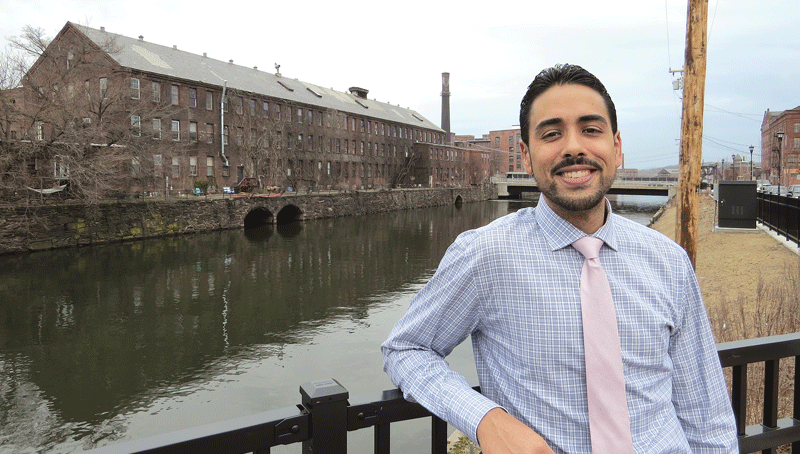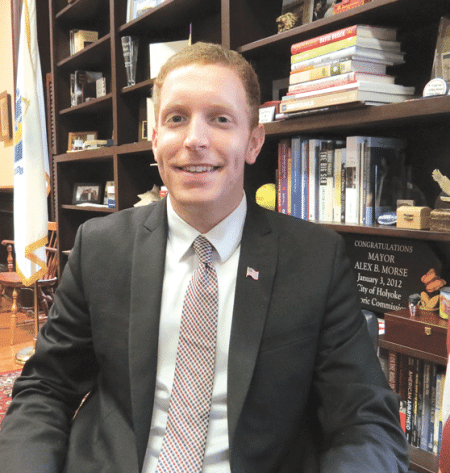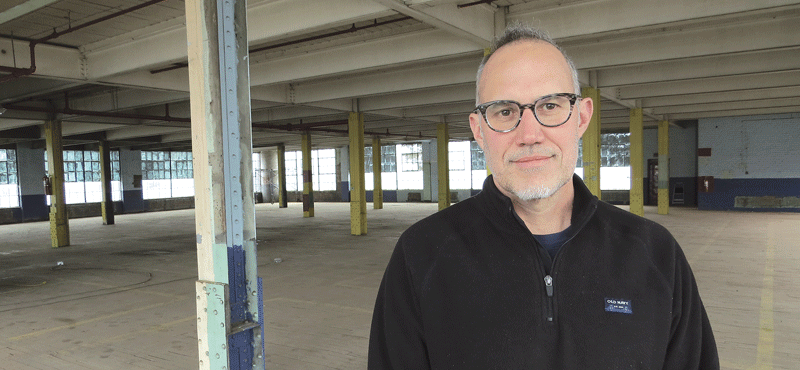Pieces of the Puzzle Coming Together in Holyoke
Community Spotlight

Marcos Marrero stands across the lower canal from a planned condo project that he says will offer “beachfront property.”
As he talked about Holyoke and the broad economic-development plan he put in place for it when he became mayor just over four years ago, Alex Morse listed a number of key strategic planks in that platform.
They include everything from improving and broadening the housing stock, especially with market-rate options that would attract young professionals, to programs that would encourage entrepreneurship; from public investments aimed at spurring private development to a focus on expanding the creative economy; from public-private partnerships to bolstering the hospitality industry.
And for evidence of progress in all those realms, he pointed (figuratively, although he could also have done so literally from a window in his office in City Hall) to the many developments taking place on — or that can been seen from — Race Street.
Indeed, that north-south artery that runs along what’s known as the lower canal in this gateway city, famous for its legacy of paper making, represents a microcosm of the progress Holyoke has seen in recent years, said Morse, and the promise it holds for the future.
Along a three-block stretch, one can see perhaps the best example of the creative economy in motion in the Gateway City Arts venture, a mixed-use property that will soon feature a new restaurant. Moving south, one encounters the aptly named Cubit building (that’s the shape it takes), which will soon house Holyoke Community College’s Culinary Arts program on the first and second floors and residential space on the third and fourth floors, in an ambitious public-private partnership.
In between those properties is a vacant lot that will become home to the latest expansion effort involving Bueno Y Sano, the Mexican-food chain launched in Amherst two decades ago that now has six locations in Massachusetts and Vermont. The Holyoke facility will be a site for manufacturing some of the food items, but it will also have an eatery.
Across the street, and then across the canal, one can see the sprawling Canal Gallery complex. Once a home to artists and vacant for several years, it is the site of a planned 50-unit condominium complex, one with dozens of windows facing the canal, thus becoming what Marcos Marrero, Holyoke’s economic-development director, affectionately calls “beachfront property.”
From Race Street, one can see the city’s new railway platform, built on the site of Holyoke’s original train station, which is being hailed as one instrument in the city’s efforts to attract new businesses and residents. And one can also see the Massachusetts Green High Performance Computing Center, touted as a spark for more technology-related ventures.

Mayor Alex Morse says the developments on — and that can be seen from — Race Street are a microcosm of the progress Holyoke is experiencing.
Also visible, but much further south, is the property at 216 Appleton St., a former mill being repurposed into housing, and still farther south is the former Parsons Paper building, which will soon be razed for a much-needed expansion of Aegis Energy Services, a provider of modular combined heat and power (CHP) systems for a variety of applications.
There are dozens of other developments in various stages of progress across the city, but the view of and from Race Street explains why there is a good deal of optimism and momentum in Holyoke, said Marrero, as well as some challenges that probably couldn’t have been envisioned a half-decade ago, but definitely fall in the ‘good-problem-to-have’ category.
“The progress over the past several years is quite dramatic, and we’re running into problems of success,” he explained. “Four years ago, very few people were saying, ‘our problem is we have too many people who want to be downtown, and we don’t have enough parking for everyone.’
“Four years ago, most people, not just in Holyoke, but across the region, would not have given this city a second glance or perceived it as a place they wanted to be,” he went on. “Now, that’s not the case; there’s a lot of momentum happening.”
For this, the latest installment of its Community Spotlight series, BusinessWest takes an in-depth look at the many forms of progress in the Paper City, and at what the future holds for this historic city on the comeback trail.
It Looks Good on Paper
As he gave BusinessWest a walking tour of the area east of City Hall down to Race Street, Marrero stopped at one point to admire the view as the limited amount of sun light on that warm March afternoon danced on the water in the upper canal near the city’s acclaimed children’s museum in Heritage Park.
Soon — and ‘soon’ is admittedly a relative term — there will be many more people enjoying similar views as residents of the city.
By Marrero’s count, there are approximately 450 units of housing — condos and apartments across a wide mix of price ranges — that are already planned or in the proverbial pipeline.
“There’s more housing in the downtown to be constructed or rehabbed than at any time since the city was first built,” he explained, while listing several projects within a few blocks of one another.
And housing represents a key component of the city’s broad development strategy, said the mayor, adding that Holyoke’s population, which was once at or near 60,000, sank below 40,000 in the ’90s, but is now back above 40,000, with hopes that it will continue to rise.
There are many reasons why the population decreased, said Morse, and, coincidentally, they mirror those economic-development platforms listed earlier, and range from a shortage or jobs to a dearth of attractive housing, to a distinct lack of incentive on the part of the development community to build such housing.
Indeed, until recently, the prevailing sentiment in Holyoke was, ‘you can built it, but will anyone come?’ with enough accent on the question mark to dissuade developers.
Recent interest in those properties on or near Race Street would seem to indicate a more positive attitude, which was effectively expressed by Denis Luzuriaga, who, with his brother, Marco, acquired the Cubit building and blueprinted its mixed-use plans (more on those in a bit).
“I see Holyoke as being not only a great place to live,” said Luzuriaga, who has called the city home for nearly 11 years, “but a place for potentially good returns on real estate as well.”
The basic development strategy for Holyoke is similar to the ones being blueprinted for other Gateway cities, said Morse, noting that, in simple terms, it involves making the community a more attractive place to live, work, and start a business — which Holyoke was until fairly recently.
There are many moving parts within this strategy, he went on, listing everything from job creation to new housing options; from incubator space in which new businesses can take root to rail service that can connect residents to jobs and clients, and connect others with Holyoke.
It will take years, perhaps even decades, for the canvas to fill in completely, but pieces to the puzzle are falling into place. And to see this — although in many cases the assignment requires imagination because projects haven’t started yet — we return to Race Street.
This artery certainly speaks to Holyoke’s past — it is dotted with old mills that manufactured everything from paper to wire, with emphasis on the past tense — but also its present and future.
Regarding the former, many of those properties have been vacant or underutilized for years, if not decades. As for the latter, the projects on the drawing board reflect broad optimism for a more vibrant city.
The Shape of Things to Come
The Luzuriaga brothers are in many ways typical of what could be considered a new generation of investors in Holyoke, lured by attractively priced but structurally sound real estate, but moreso by the city’s potential to reverse its fortunes.
Denis Luzuriaga told BusinessWest that he was a dabbler in commercial real estate, focusing on multi-family homes, when he decided to takes things up a notch — or two. And when deciding where to scale up his activities, he focused on the Paper City because of its attractive opportunities and recognizable momentum.
The Luzuriagas hadn’t officially closed on the 50,000-square-foot Cubit building (purchase price $350,000) when Holyoke Community College put out a request for proposals for a location in the city’s downtown in which to relocate its Culinary Arts program, but they submitted a proposal anyway.
It wasn’t chosen by the school (none of the bids in that round were), but it did garner some attention. And when the winner of the next round of submissions couldn’t make that plan materialize, the school went back to the Cubit building.

Denis Luzuriaga, who, with his brother, Marco, is rehabbing the Cubit building, is among a new generation of investors in Holyoke.
Work on that project is slated to begin in a few months, said Luzuriaga, adding that roughly the same timetable applies to the residential component of the property — 18 units of market-rate apartments. At present, work is ongoing to replace the large windows that pour natural light into the property, which has housed operations manufacturing everything from shoelaces to corsets to wire.
Looking back to when he arrived in Holyoke, Luzuriaga said he liked what he saw — an old mill city with history, character, and potential. And now, he likes the picture that much more.
“There was something about this city, beyond the people and the way it looked, especially in the downtown area, that was very attractive to me,” he said. “I could see the potential for all kinds of positive change.”
So could Lori Divine, when she and fellow artist Vitek Kruta created Gateway City Arts in 2012. The venture has grown over the years, and now puts under one roof everything from learning areas to co-working space; from an event facility to incubator facilities for food-service businesses.
Actually, it’s two roofs (there are adjoining buildings along Race Street), and the expansion process is ongoing.
Indeed, the venture now includes Gateway City Live, which, as that name suggests, hosts a wide variety of live entertainment and events ranging from ‘tango nights’ to weddings. Coming next is the Gateway City Bistro, set to open in June, which will bring another much-needed eatery to the downtown area.
Divine and Kruta were so intrigued by the possibilities downtown that they acquired the Steam Building further down Race Street, so called because it once housed a steam-equipment manufacturer, and renamed it the STEAM (Sustainability Technology Entrepreneurship Art Media) building, with intentions for more mixed-use activity. It currently hosts a few businesses, including a web-design company and an alternative education program called Lighthouse, and will soon be home to a karate studio.
Assessing the scene along Race Street, and Holyoke in general, Divine sees momentum accumulating at a solid pace.
“It’s really exciting,” she said. “The Canal Walk is beautiful, the area is safe — and I know safety is a big issue for people — and it’s fun. It’s just a great place to be.”
Looking forward, the obvious goal is to prompt more residents and business owners to say just that, said Morse, adding that there is progress on both fronts.
The Parsons Paper demolition and cleanup, a long-awaited development after fire extensively damaged the site two years ago, will enable Aegis Energy Services, one of Holyoke’s fastest-growing companies, to expand in the city, he said.
Meanwhile, programs such as the SPARK (Stimulating Potential, Assessing Resource Knowledge) initiative, launched by the Greater Holyoke Chamber of Commerce, helps residents develop ideas into businesses.
“We want to encourage entrepreneurship, and we’re been recognized as one of the leading cities in that regard,” he explained, citing the city’s presence on a listing in Popular Mechanics. “This is a city with a history of entrepreneurship and innovation, and it continues today.”
Building Momentum
Luzuriaga believes Holyoke can and will attract more investors, turn its fortunes around, and become a true destination. And that optimism stems from the fact that he’s seen such a reversal of fortune up close and personal.
That was in Jersey City, N.J., a community across the Hudson River from Manhattan that had fallen on hard times and was making progress with the hard work of getting back on its feet while Luzuriaga lived and worked there.
“When I moved there 20 years ago, you could see that it had seen better days,” he explained. “It took a lot of effort by developers and city officials to get a steady pace of growth going, and I see the same type of thing happening in Holyoke; all the indicators are there.”
Luzuriaga says Jersey City was just starting to hit its stride by the time he relocated to Holyoke nearly 11 years ago. But he visits friends there often and marvels at the turnaround.
In Holyoke, he expects to not only witness the turnaround, but be a real part it. And he’ll have a front-row seat — right there on Race Street, at his beachfront property.
George O’Brien can be reached at [email protected]
Holyoke at a glance
Year Incorporated: 1850
Population: 40.135 (2012)
Area: 22.8 square miles
County: Hampden
Residential Tax Rate: 19.12
Commercial Tax Rate: 39.86
Median Household Income: $33,242
Family Household Income: $39,130
Type of government: Mayor, City Council
Largest employers: Holyoke Medical Center, Holyoke Community College, ISO New England, Universal Plastics, Marox Corp.
* Latest information available




